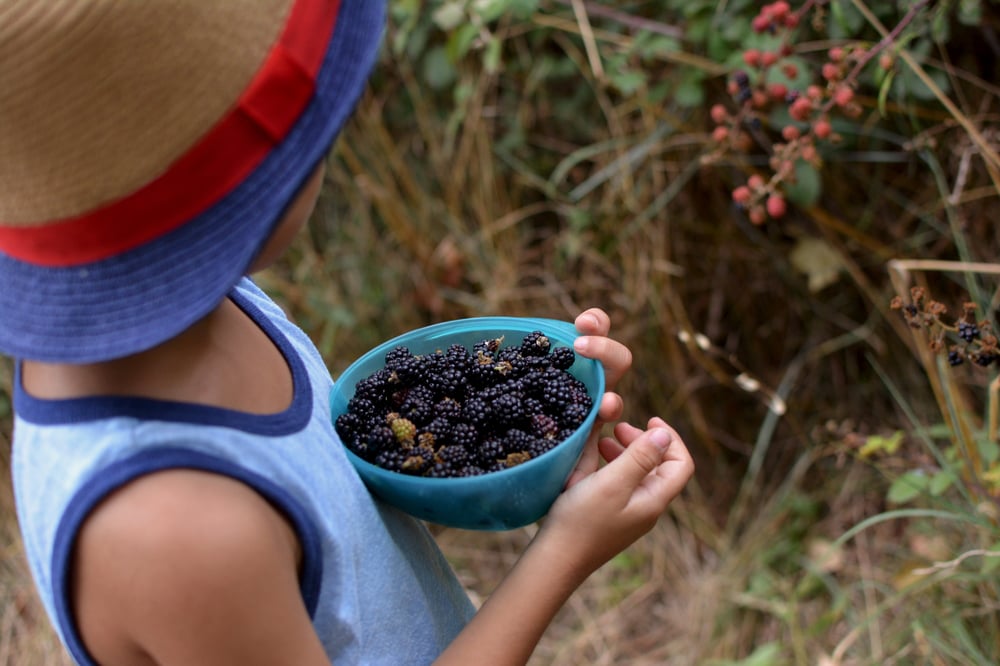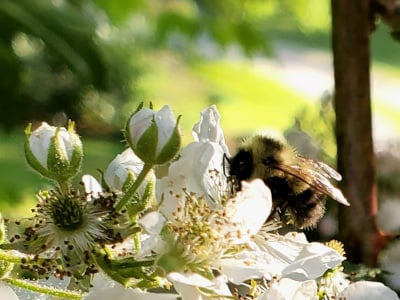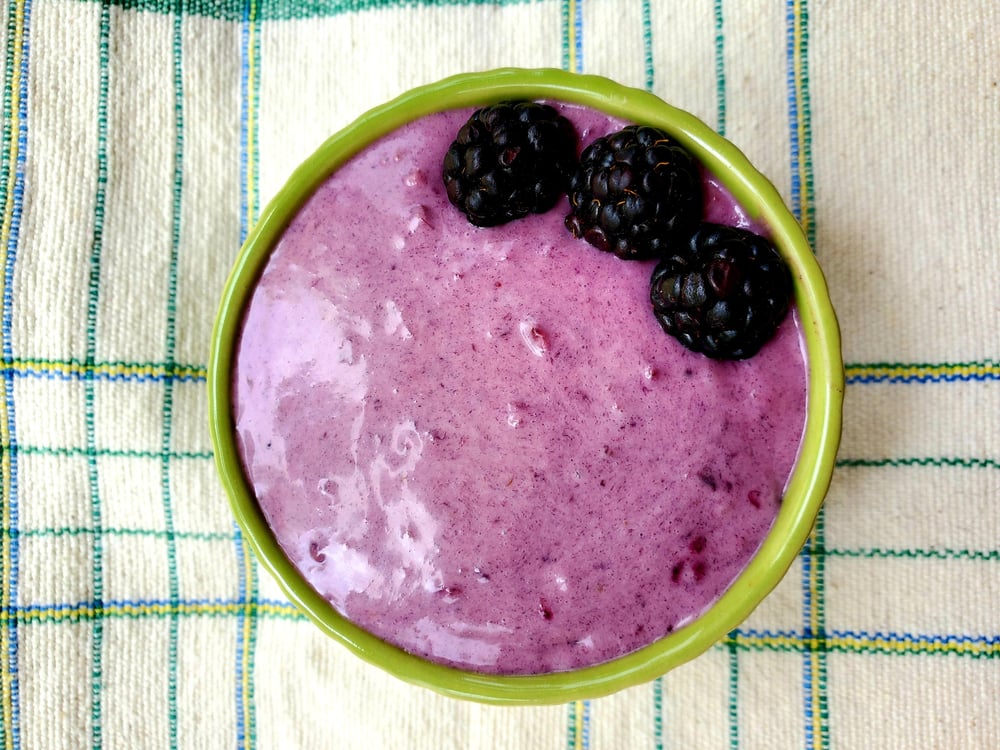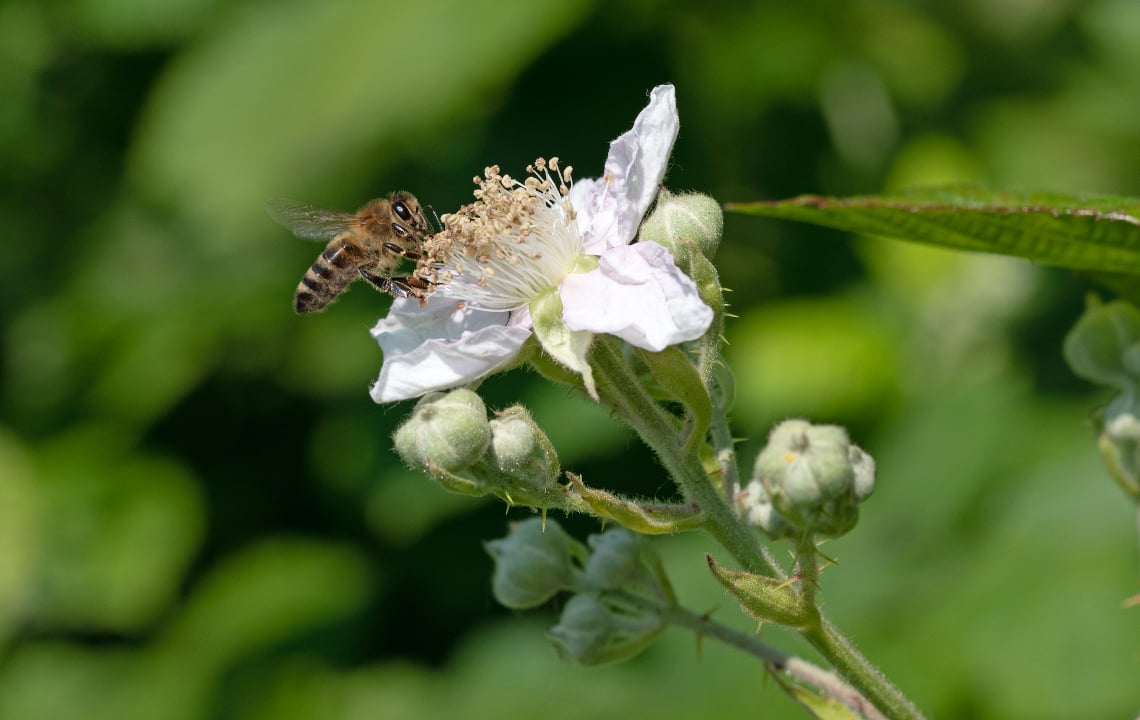Wild blackberries, abundant and delicious, ripen between June and August in the South. Take your kids, invite a friend and make a summer mini-adventure out of foraging for this healthy fruit.
No matter where you are in the South, you likely have access to wild blackberries, cousins of the grocery store varieties you're used to.
Blackberries offer foolproof foraging and is an easy plant to get started with if you're a beginner.
Blackberries are abundant, have no harmful look-alikes and don't require special preparation before eating.
Foraging is also a great activity for kids. They love fruit and are excited to find food in nature. And they'll benefit as much as you from the fresh air, exercise, and sunshine that come along with foraging.
Read this guide to learn more about these delicious fruits and start planning your summer foraging day.

The Berry That's Not Really a Berry
Botanists tell us blackberries aren't really berries; they're aggregate fruits because each tiny bead that makes up the "berry" has its own seed.
They call these beads drupelets, but you don't have to. To most of us, the tart-sweet fruit is a berry, best eaten just after picking. They're also delicious in smoothies and on top of ice cream.
But flavor isn’t the only benefit of eating fresh blackberries.
Nutritionists recommend blackberries for their high vitamin C content, a one-cup serving provides 35% of daily requirements. One cup also provides 30% of daily fiber needs. And blackberries are known for their anti-inflammatory and antioxidant properties.
Before modern scientists studied the blackberry's impressive nutrient profile, European and North American folklore pointed to the widespread use of the plant for its healing properties.
A Greek physician writing in the first century described blackberry jelly as a sore throat remedy. In Scotland, the roots have been used to treat bronchitis and asthma. And the Iroquois used the plant for coughs and colds. Other healers used the leaves to treat toothaches, burns and swelling.
Know Where to Look
You probably saw blackberries blooming this spring on the sides of the road or on field edges. They grow in thickets, first on upward stems and then arcing over.
In late spring—often around the last cold snap—they erupt in clusters of white flowers.
Blackberries thrive in forest openings and areas humans have disturbed and then abandoned, especially in open, sunny sites. You'll find them on old logging roads, in neglected fields, beside streams and maybe in your own backyard. 
Look for dense shrubby thickets. You'll see compound leaves made up of three or five smaller leaflets and the beginnings of berries.
In late spring and early summer, the little clusters of fruit begin to grow after the flowers fade. First, they're green, and then red, before they finally turn black as they ripen.
In Georgia and Florida, the berries may ripen as early as June. In higher elevations of the Southern Appalachians, it may be August before they’re ready to eat. Take care with blackberry's thorny stems while picking. It's best to wear long sleeves and pants.
You probably know this, but check the rules on foraging if you're on public land. Foraging for personal use is often allowed in national forests and state parks, but be sure before you start picking. If you see blackberries on private land, don't rule it out, but get the landowner's permission first.
As always with foraging, avoid areas that have been sprayed with herbicides or pesticides. If you are concerned about an area, like a roadside, move on to a more remote area. Besides, you’ll have more of an adventure that way, too.
Recipe Ideas
Now for the best part–eating those delicious blackberries. Nutritionists say it’s best to eat them fresh, but if you have extra, you can freeze them and preserve most of their nutrients.
Blackberries pair well with lemons and sweeter fruits like apples and peaches. Vanilla complements their tartness and blends well with other flavors.
You might try blackberries in:
- Summer salads with goat cheese and sunflower seeds
- Smoothies with peaches and cinnamon
- Sangria with blueberries and strawberries
Or try this blackberry-sweetened fruit dip. It’s inspired by a version of coconut fruit dip created by paleo food blogger Jill, author and creator of Simply Jillicious. Like all the best food writers, Jill crafts recipes that are both tasty and healthy, including her low-sugar fruit dip.
Our version is sweetened with blackberries and applesauce.The blackberries lend a bright purple color to the dip, making an eye-catching centerpiece for a tray of your favorite fruits.

Coconut & Blackberry Fruit Dip
Ingredients:
- 1 can full-fat coconut milk, chilled in the fridge for several hours
- 1 ½ teaspoons vanilla
- ½ cup fresh or frozen blackberries
- 2-3 teaspoons unsweetened applesauce (to taste)
- ½ teaspoon lemon juice
- pinch of sea salt
instructions:
- Chill the can of coconut milk in the refrigerator for several hours, preferably overnight.
- Open the coconut milk from the bottom of the can, and pour out the liquid, reserving the solid coconut cream at the top of the can. You can freeze the liquid for use in other recipes.
- Combine the solid coconut cream with the remaining ingredients in a blender or food processor, and blend on high until smooth.
- Taste the dip, adding more flavorings as needed.
- Serve with your favorite fruits and enjoy! Store in the refrigerator for 3-4 days.
Whether you make this recipe or create something of your own, we’d love to hear how it goes.
Snap a photo of your Blackberries and tag us on social media!
And most importantly, enjoy nature’s gifts this summer.
Read more of our stories to inspire a fun, relaxing summer this year:
Simplify your fishing so you'll fish more often
How to attract wild birds to your property
Summer activities for country kids
Sources:
- Hatfield, Gabrielle. 2004. Encyclopedia of Folk Medicine: Old World and New World Traditions. ABC-CLIO.
- Kanuckel, Amber. Updated May 12, 2021. How To Identify Common Wild Berries: Timely tips on how and what to look for when picking wild berries, and spotting their look-alikes. Farmer's Almanac.
- Healthy Coconut Honey Fruit Dip. Accessed June 3, 2022. Available at: https://www.simplyjillicious.com/healthy-coconut-honey-fruit-dip-gluten-free-vegan/.
- Spira, Timothy P. 2011. Wildflowers & Plant Communities of the Southern Appalachian Mountains and Piedmont. The University of North Carolina Press.
- Xu, Tianyou, et al. 2022. Blackberry Fruit: Nutrition Facts and Health Benefits. Virginia Cooperative Extension.

























